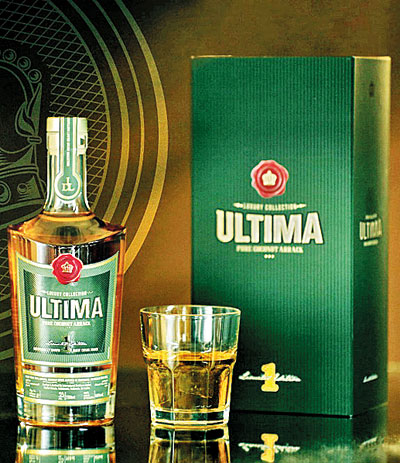Branding Opportunities that Sri Lanka lost – part ii
View(s): In one of the previous articles, I tried to highlight the opportunities that Sri Lanka lost in creating world-renowned brands in the space of carbonated Soft Drinks a local origin brand that came into existence in 1876 (with a history of more than 120) years and a brand in the ready-made garment fashion outlet chains with a history of more than 60 years. This article revolves around another category that is well-known to Sri Lanka as we top the list of countries with the highest per capita consumption of alcohol. Though Sri Lankans are religious and live on values, it’s strange to see the level of alcohol consumption in the country. Alcohol production was introduced to Sri Lanka by the British and, ever since then, there have been many brands catering to the needs of the local market. But none could reach the world market in a successful way other than Lion Beer which has also not reached its full potential in the export markets.
In one of the previous articles, I tried to highlight the opportunities that Sri Lanka lost in creating world-renowned brands in the space of carbonated Soft Drinks a local origin brand that came into existence in 1876 (with a history of more than 120) years and a brand in the ready-made garment fashion outlet chains with a history of more than 60 years. This article revolves around another category that is well-known to Sri Lanka as we top the list of countries with the highest per capita consumption of alcohol. Though Sri Lankans are religious and live on values, it’s strange to see the level of alcohol consumption in the country. Alcohol production was introduced to Sri Lanka by the British and, ever since then, there have been many brands catering to the needs of the local market. But none could reach the world market in a successful way other than Lion Beer which has also not reached its full potential in the export markets.
Despite the fact that 4,201 deaths per 100,000 population (from alcohol-attributable liver cirrhosis, road traffic injuries, and cancer) occur due to alcohol, during the economic meltdown government had to keep the bars open to collect tax revenues. The prevailing situation of a thriving illicit alcohol market invites the formation of a National Alcohol Policy Framework which should be composed of a wide range of stakeholders and should include representatives from Local, Provincial, and Local governments, academia, non-governmental organizations, and the alcohol beverage and hospitality industries. The National Alcohol Policy should be a comprehensive, collaborative strategy that provides direction and recommendations to reduce alcohol-related harm by focusing on the eradication of Illicit alcohol. Needless we as a nation spend a colossal amount of dollars to buy quality and branded liquor products from single malt to various other brands. Despite the harm it brings to our lives, the tax revenue from arrack has increased from LKR 20.6 million in the year 2006 to LKR 113.6 million by 2017. It’s evident that the tax revenue earned from liquor is less than USD 1mn per annum. What have we missed here? Are we focusing on the right revenue model?
History of Alcohol in Sri Lanka and Origin of making local arrack
The Mahavamsa show that there were spots where Toddy was sold in ancient times such as the pre-king Dutugemunu era. It is now known that Ceylon, as the island was called when it was a British colony, exported large quantities of Arrack made of Toddy to India as far back as the early 19th Century. It is recorded that a century later, there existed some 250-300 distilleries in the district of Kalutara alone.
In 1505, with the Portuguese invasion of Sri Lanka, the situation changed and promoted the drinking habit among Sri Lankans. The Dutch invaded the country after the Portuguese continued the propagation of alcohol. With the arrival of the British, introduced the first Excise Ordinance in the form of the Toddy Act of 1912 and liberally introduced licenses to open taverns in most parts of the country, to increase the state revenue, promoted the drinking habit. Reliable records, during the British period, show that toddy tapping in the Kalutara area started in the 1870s. It is said that the governor Sir William Henry Gregory (1873- 1877) developed this industry in the Kalutara area and this industry was limited only to a few families. Distilleries Company of Ceylon was established after the development of toddy tapping. Mr. Elaris Cooray and Dr. Edmond Cooray who lived in Wadduwa gave a new life to the toddy industry by introducing new technology to brew arrack.
Famous local arrack brands
Dated back to 1913 the Excise Department was formed to manufacture liquor (Arrack) for the local market. Operations became more streamlined subsequently, especially when the state established its own distilling facility. This situation continued for 60 years until 1974. During this period the main distillery of the state was located in Galoya Valley and the brand name “Galoya Pol” and “Gal Arrack” became popular among alcohol consumers. Since the privatisation of Sri Lanka’s alcohol industry in March 1992, the volume of liquor produced in the country has leaped to a record level of 46.9 million7 proof liters of all categories of legally produced Arrack in 2011 from 14.9 million 8 proof liters in 1991. During the period of 20 years, production has increased by 216 percent.

The opportunity lost
Whilst focusing so much on the local market, all the manufacturers of arrack in Sri Lanka missed the opportunity of exploring the international market. Pure Sri Lankan coconut arrack clearly had the opportunity to conquer the world market. What Sri Lanka lacked was the quality, branding, and effort to take it to the rest of the world. Food and travel writer Anthony Bourdain described it as tasting like “a marriage of bourbon and rum, but with a stronger punch that comes with a burning sensation and a mysterious bouquet”. Yet the makers of Sri Lankan arrack – best described as a dark coconut rum – believe it is still punching far below its weight when it comes to international recognition and appreciation. Singaporean bar Native uses Ceylon Arrack in one of its cocktails, and its owner and head bartender Vijay Mudaliar says it has been a bestseller ever since they introduced it.
Conquering International Markets
For years, arrack was considered too “low class” to be taken seriously as premium alcohol, even in Sri Lanka, where the elite in Colombo preferred Single Malt Scotch whisky, wine, or rum. Pioneers in branding local arrack to the international markets are Mendis Arrack, Rockland Arrack, and International Distilleries.
Taste, mouth feel, authenticity in production, balancing alcohol percentage, and consistency in quality are the key to success as far as the product is concerned. Brand variants can include Premium Virgin Coconut Oil Arrack. One of the main strategies to skim the market would be to introduce limited editions. The picture indicates one of the premium pure Ceylon arrack brands introduced to the market as a limited edition. Packaging, the bottle shape, and having a stopper are prerequisites. As far as the price is concerned, the price needs to reflect the quality which means it has to be a higher price. Distribution wise the focus should be on international markets, and if it’s made available in Sri Lanka it should be only in star-grade hotels, premium clubs and pubs, supermarkets, and airlines. When it comes to promotions, it should be promoted and associated with a sport such as Golf and Sailing to create the right associations. Viral marketing, blogs and social media marketing can play a crucial role in promoting these in the international markets. The time has come for Sri Lanka to capitalize on these lost opportunities and introduce value additions to command a premium price and bring as much revenue as possible instead of merely focusing on the local market and being happy with penetrating the local consumers. Strong associations such as Ceylon, Coconut, the taste pallet, and historic association with British distilleries, are immediate marketing ques that can be instrumental in the effort. It should be noteworthy that lighting a candle is more important than cursing the darkness.
HitAd.lk is the best and biggest mobile phone market in Sri Lanka, and we guarantee you will find what you need here from our extensive listing of mobile phones for sale in Sri Lanka. Whether it’s a budget-priced smartphone for communication, or higher end features with advanced connectivity, there are many different options from which to choose from on our site!


